
Baker/author Ken Forkish, in Flour Water Salt Yeast: The Fundamentals of Artisan Bread and Pizza, makes an impassioned and compelling argument for home- baking in Dutch ovens.
He writes of his struggle to achieve the same “texture, crust, color and oven spring…” in his home oven compared to: “[what]… we get in the bakery using the 15,000-pound Italian deck oven, with steam at the push of a button.” Shortly following he expresses his gratitude to authors Jim Lahey (My Bread) and Chad Robertson (Tartine Bread) for introducing him to using Dutch ovens for home bread-baking, their books recognizing “…previous techniques for home baked hearth bread, most often baked on a pizza stone with myriad methods for producing steam, were insufficient for recreating the oven steam we enjoy as professionals bakers”
I don’t bake bread at home in Dutch ovens. I made this choice five years ago. I’m and old man. I suffer from arthritic degradation in my spine. If I overdo it I hurt. I’m also a klutz. Throughout my lifetime I’ve frequently tripped over matchsticks. My choice was made for personal safety. I don’t feel comfortable wrestling a pre-heated Dutch oven bent over an open, heated home oven. There are also secondary reasons. One looms large in my reasoning: my favorite loaf shape is the batard. It appears Dutch ovens, with few exceptions, dictate “Only Boules”.
I own six Dutch ovens: three of them are made from raw cast iron (two of them have three short legs for campfire cooking/baking), three of them are enameled cast iron. The oldest two were purchased, by me, in the 1950’s; the youngest three years ago: an enameled Lodge—made in China. It’s my least favorite (its interior stains). Two (Le Creueset) have some-kind-of-plastic handles that would be harmed at bread-baking temperatures. I could remove them, but that would make wrestling covers more difficult. I’d probably drop one on my toes. The two with legs don’t sit well in ovens. Also, only my oval Le Creuset would allow baking my favorite bread shape. Forget baguettes.
I love Dutch ovens.
But I won’t bake in them for the reasons stated above.
When I read author Forkish’s declaration my first thought was, “What am I missing out on?” I scanned through the rest of his book, and my copy of Tartine Bread, but found nothing quantifying the shortages in texture, crust, color and oven spring my naked-in-the-oven-with-insufficient-steam breads achieve.
I didn’t doubt there are differences. I simply wanted to know, “What are the differences? How “big’” are they?”
I decided I’d do an experiment. I would simulate a Dutch oven by placing a six-inch deep, fourteen-inch diameter stainless-steel bowl over a 500 gram boule-shaped loaf resting on my preheated baking stone. I would insure the bowl was placed such that its entire rim rested on the seventeen inch wide inch baking stone: an easy challenge.
I would then compare it to an “identical” boule baked in my usual manner.
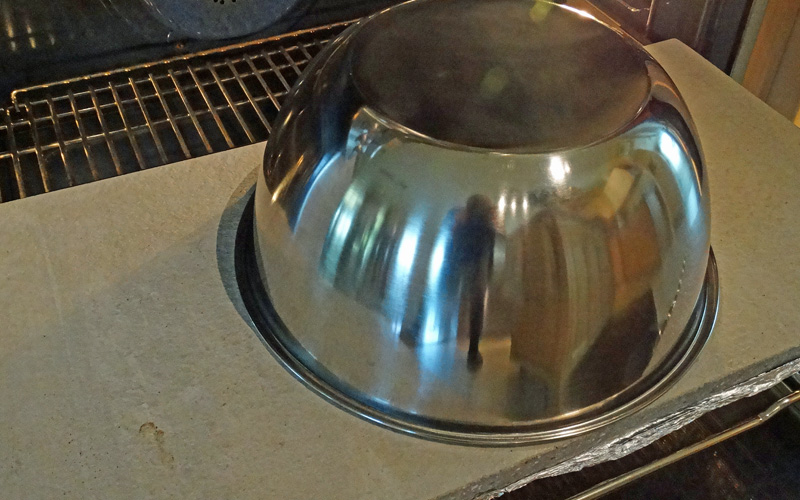
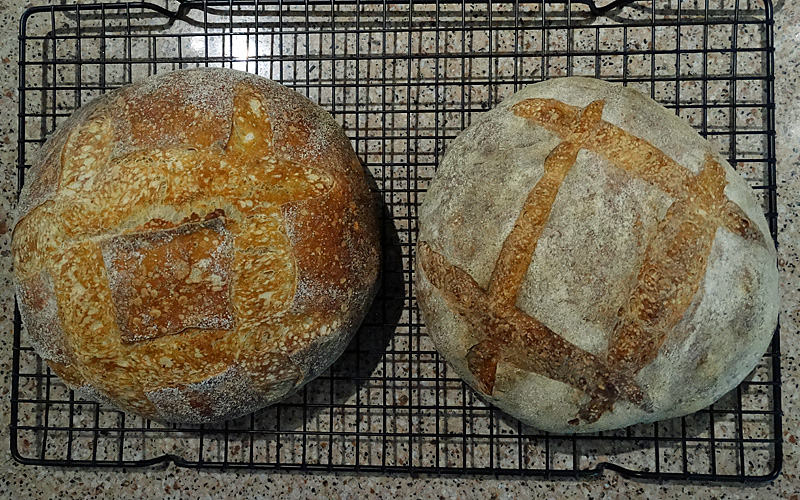
In this picture and the two following the bowl-covered loaf is on the left.
These loaves, each 500g, were from the same dough (70% hydration, natural levain only) but proofed seperately and baked serially. I was concerned that if the differences were slight how the exterior "wet" oven air might muddy the outcome. I need not have worried.
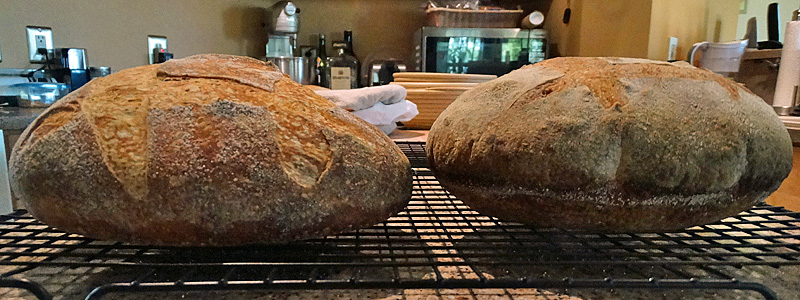
My visual assessment was the covered loaf had expanded more then the conventionally baked loaf, but after seeing the difference in shape, and loft I wasn't entirely convinced.
I placed each loaf in a thin plastic bag and extracted the trapped air from each bag. the plastic became a thin skin clinging to the loaves crust. I carefully immersed each loaf in a bowl filled to its rim with water. I collected and measured the overflow in milliliters. The cover-baked loaf displaced 10% more water than the conventional loaf, indicating its volume was the greater. Additionally, I weighed the two baked loaves. The differed in weight by only 2 grams (less than 0.4%)--the cover-baked loaf was the heavier..
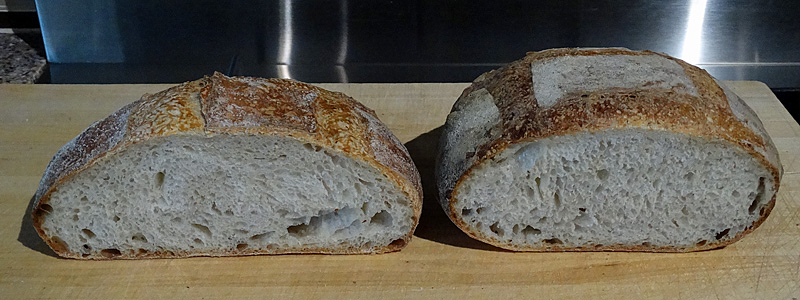
The crust on the cover-baked loaf is noticeably thinner than the conventional loaf, but I made no effort to measure the difference. Interestingly, I perceive, in this picture the crumb of the conventional loaf exhibits less random bubble size, but overall appears to be slightly more open than the cover-baked loaf. However, the variance seems small, and slices elsewhere in the loaves compared randomly.
The volume difference vs. weight difference would suggest the cover-baked loaf's crumb is slightly more open.
Both my wife and I ate multiple samples of both loaves. Neither of us perceived any difference in flavor or chewiness of the crumb. The cover-baked loaf's crust is, not surprisingly, less chewy. My wife prefers it. I couldn't perceive any difference in crust flavor; my wife didn't have an opinion.
The 10% volume difference in oven spring caught my attention.
I've not been disappointed with the oven spring I've been routinely achieving. (I think the photographs justify my satisfaction.) But, if I can get more, without having to wrestle with eight pounds of piping-hot DO, I'll take it. But first, I wanted to be certain my one trial was typical.
I did it again: with a couple refinements, a week later.
1. I baked the loaves simultaneously: one covered, one conventionally
2. I increased the dough weight per loaf by 100g. I reasoned this should make any volume difference more observable.
3. I shaped the loaves into batards.
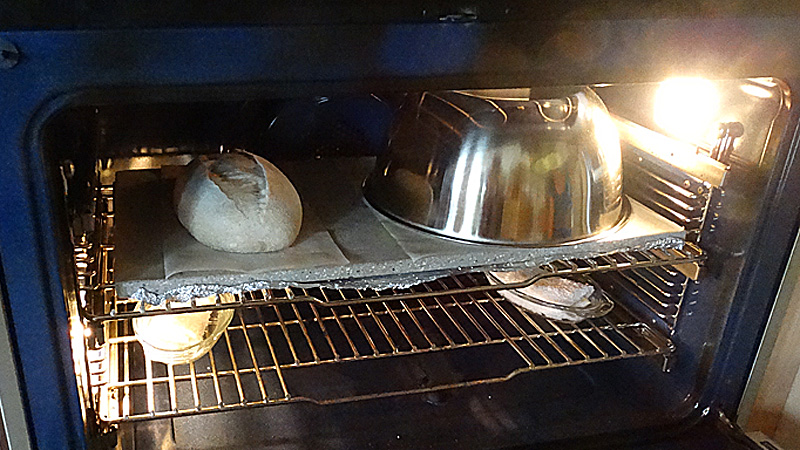
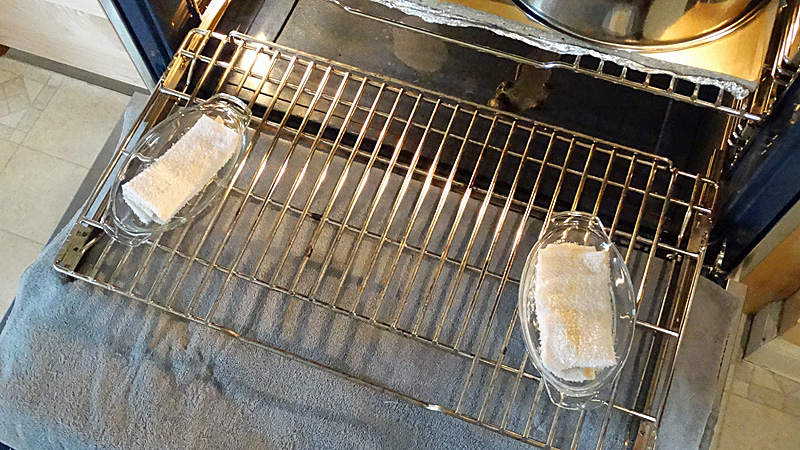
My usual steam source is two small vessels containing a rolled up towel fragment, and filled with boiling water. I don't load loaves until I can see boiling restored.
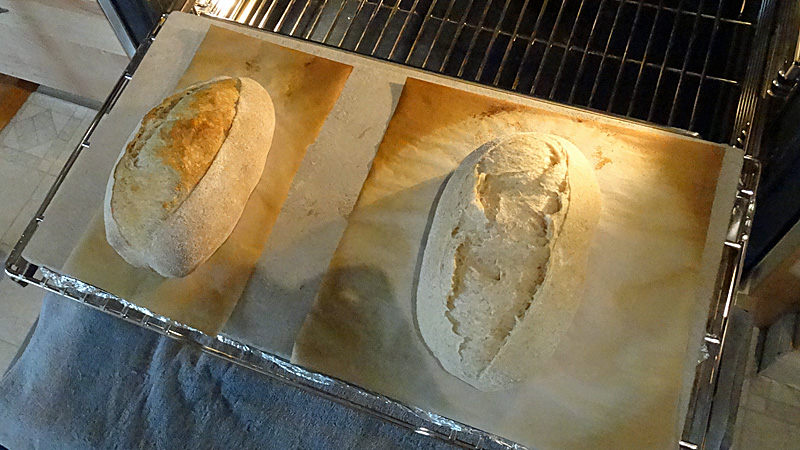
The volume difference was immediately noticeable.
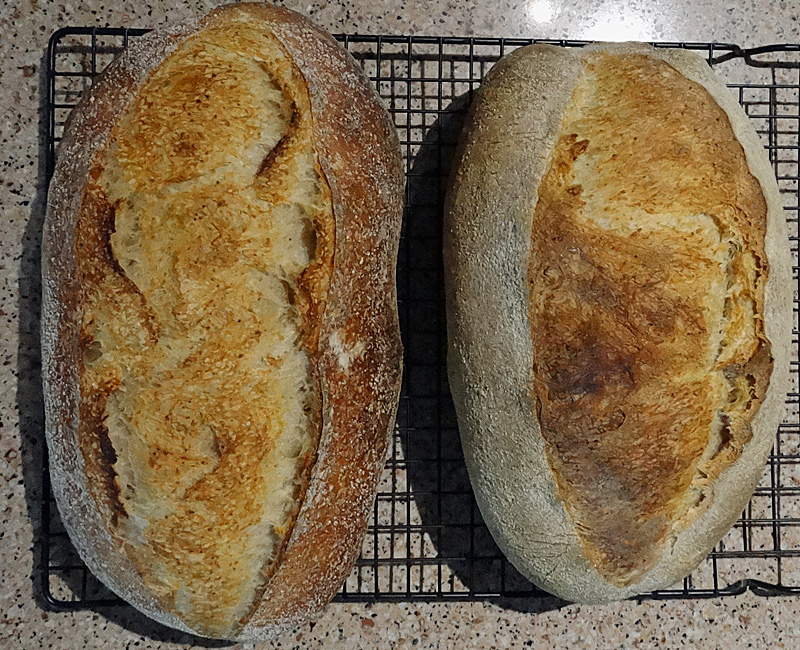
I didn't repeat my immersion measurement. These loaves' volumes clearly differ by at least 10%.
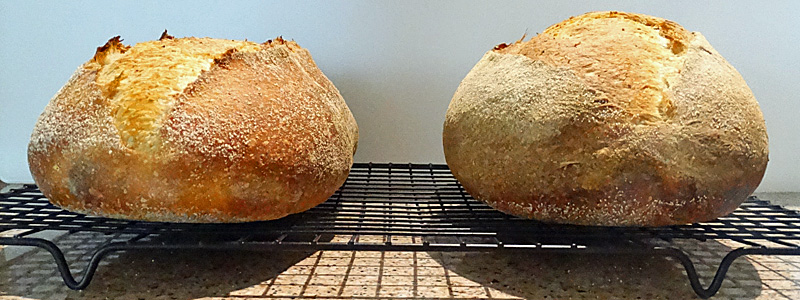
However, the conventional loaf agian exhibited greater loft.
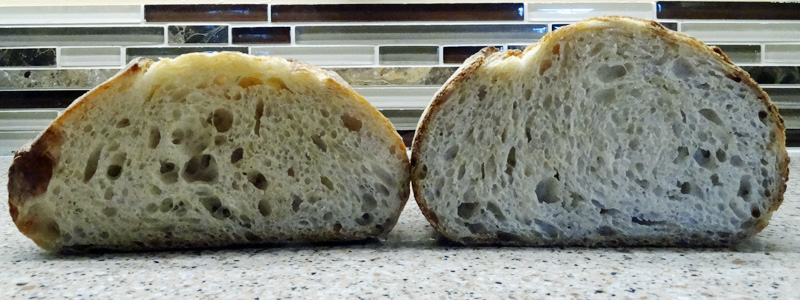
The other observables: dissimilar crust color and surface texture, thinner crust are essentially the same. The crumbs' structure remains, to me, inconclusive as well as flavors.
Let me hasten to add these results may not be representative of results in true Dutch ovens.
I'm going to buy a second stainless steel bowl.
Happy baking,
David G
- davidg618's Blog
- Log in or register to post comments
Thanks for posting. I'm weigh 100lbs and have small hands. Handling the heavy Lodge DOs (I do 5 at a time) are definitely not fun for me and there is a lot of grunting and cursing involved!
I'm going to continue exploring this alternative. I only a bake a small quantity--2 or 3 loaves, once weekly, and I especially liked the increased oven spring, and crust texture and appearance. Furthermore, relying on the loaves intrinsic water vapor I don't have to deal with steam making gear.
Janet (next post down) has suggested food service steam pans. I've looked at them online and I'm certain I can do at least 2 one-pound loaves , and maybe three under one 6" deep pan. I buy most of my cooking gear from a local restaurant supply business; super friendly and helpful, and happy to sell to the public. Intend to get one this week.
I'll post results.
David G
Interesting study. I recall doing something similar but eventually gave up using the DO due to weight and shape. I ended up making my own cloches out of flower pots and they were much easier to handle though, when baking multiple loaves which I do regularly, one can only fit 2 loaves into my oven rather than the usual 4.
I am not sure if you know about ss steam table pans but I tried those too since their shape accommodates batards as well as boules. They come in a variety of sizes and I did use one for awhile, but again the space with multiple loaves became an issue so I am back to the old lava rocks in a Lodge frying pan with boiling water....
I too am an older baker so putting the money into a really nice commercial oven is an idea I do not let myself think about though Pleasant Hill Grain sells a couple of nice counter top models that I do let myself gaze upon in moments of weakness......but the sticker price is a bit much....
Thanks for Sharing.
Janet
My baking is for friends and family only: 2 or 3 modest size loaves weekly. Thanks for the tip re steam service pans. I doubt I would have thought of them. I'm going to buy a 20" x 12" x 6" this week, and use it for this week bake.
David G
I had to smile when I read your response....My baking saga began with baking for family only too....then friends....then more friends....and more friends...my retirement free time is happily filled baking lots of different kinds of breads from many people now. I love to bake breads, as many varieties as I can and am wonderfully happy that I get to do it so often which I couldn't do without the help of my family, friends and all I learned here.
I thought up the steam pans when my DO no longer served me and I saw them at a restaurant supply store where I shop. I think you will be happy with one. They are sturdy and hold in the steam/moisture well and are easy to manage as well as rise out when done.
Enjoy,
Janet
...here, and my wife also keeps us in sandwich bread, made with our Zo bread machine. I gift many local friends with bread often, and family too (but less often because of geographic separation). Friends asked if I'd sell them bread (and my homemade wine too) but I always say No! with as much grace and firmness I can muster. Throughout my life I've always had at least three hobbies competing for my spare time, and, now long retired, nothing has changed. Additionally, I've told other retired workaholics in the community I will organize a class to teach them how to do nothing: without guilt. I can nap or just loaf with the best of them. I've been retired for twenty years. I loved every job I worked in past years, but Retired seems to be my real calling.
I just returned from my local restaurant supply store with a 6" deep full-size steam pan.
Stay tuned.
David G
This morning, after an overnight fermentation I baked two, one-lb.(baked weight) loaves of 40% Whole Wheat sourdough (all natural levain). This is a bread formula I bake frequently.
I baked them at 450°F for 15 minutes under the steam-table pan I bought yesterday. Finished in 8 minutes pan removed: internal temperature 210°F.
There is clearly room for a third loaf--my weekly bake is usually three loaves.
I'm pleased with the outcome: but aside from the observable increase in oven spring and differing crust-surface texture I don't perceive any significant change in flavor, crumb structure and mouthfeel.
Nonetheless, I'm going to use this method for the next few weekly bakes. It may or may not become a part of my usual discipline.
Pros: approximately 10% more oven-spring. Easier: no steam management. Equivalent flavors and textures. Eye-appeal marginally more attractive.
Con: Just one--the dough mass spreads slightly wider and lofts slightly less than the same dough baked conventionally. Subjectively, I prefer the loftier loaf, but it's not a show-stopper.
Thanks again, Janet, for the steam-table pan idea.
David G
from a CI DO (actually a combo cooker) but the Mega Steam method and baking on a stone or the SS overturned bowl is very close. I like these baking method and steaming experiments.
all the bread looks great by the way. Well done and happy baking David
But after reading Forkish's condemnation of home-oven steaming strategies I've been thinking about alternatives. One of my ideas was along the lines of Mega Steaming: more surface area = more steam. However, I've tried the covered loaf approach first, and am pleased with the results, which include K.I.S.S. (Keep it simple, Stupid!) Emulating a Dutch oven with a relatively light-weight SS bowl or steam-table pan will eliminate the need to generate steam. A thin sheet of steel will transfer oven heat quickly enough that preheating the steel container won't be necessary.
I'm going to continue to explore this method. It may fall short of using a Dutch oven, but I'm reminded of a phrase I quoted frequently to my staff when I was still in the work-world.
"Better is the enemy of Good Enough!"
Regards,
David G.
Great experiment - I loved reading about your trials. I am always wondering too what the differences between all of my methods really are (I do all three at times: uncovered with steam, covered with bowl and DO).
Over the past couple of years I've become complacent about the reliable quality of my breads. This is a new plateau for me.
David G
I am an old broad, but continue to use my hand me down dutch ovens for my breads on a regular basis. The Do method is the most reliable method I have found for a home baker. If it is too much for you, do the best you can with other methods.
is the statement that "My usual steam source is two small vessels containing a rolled up towel fragment, and filled with boiling water. I don't load loaves until I can see boiling restored." To me the primary purpose of the DO is to simulate the steaming properties of a commercial oven so I get nicely caramelized crust. I have not tried your technique but will... soon
I bake reliably beautiful loaves year in and year out with a lodge cast iron pan with no feet and no plastic handles, and advise you to try it. It's $40 or less at Amazon.
I have tried the inverted caterer's tray with pretty good results when cooking baguettes.
There are bannetons available which are oval, for batards. Use one of those and carefully transfer the dough to the heated pan and you will have the batard you are looking for.
I've been baking bread in Dutch ovens since I was a boy scout. The time following included 31 years as an adult volunteer, training both adults and boys in leadership and camping skills including campfire cooking skills. A colleague and I once made a Baked Alaska in a DO with campfire coals, just as a stunt.
As I said above. I love Dutch ovens. The point of the experiment was an attempt to understand what I'm giving up by choosing to bake breads in a more conventional way.
I'll repeat: I don't want to wrestle with an eight lb. DO--I weighed one of mine--heated to 500°F. bent over an oven door also heated to 500°F. All for 10% more oven spring, and, perhaps, a marginal improvement in crust color, flavor and texture? No. The breads I bake now taste, feel and digest good enough for us, and they get plenty of "Wows" from friends and family. I'm a firm believer in the K.I.S.S. principle.
That said, I'll continue to do experiments with techniques and/or gadgets that further improve my bread baking.
Happy baking,
David G
P.S. Here's a pic of one of my oval bannetons I use frequently and the largest, legless DO I own (10.5" diameter).
D G
It's always interesting and informative to see side by side comparisons, especially when they address questions I wonder about but haven't worked up enough initiative to try to answer myself.
Curiosity has always been a long suit. If I can try out something new in my weekly bake I do, as long as it doesn't threaten the bake: it's our daily bread. We haven't bought a loaf of commercial bread in the past 12 years.
Thank you for the "Thank you"
David G
if the spreading of the covered loaf had something to do with a possible temperature drop soon after covering. Wondered if a lag time existed under the stainless cover contributing to the spread and if so could it be compensated by
1) either putting the covered loaf to bake sooner (5 to 10 min shorter final proof time) than the uncovered loaf?
2) or if covering one loaf 5 minutes into the bake might set the lower and side crust sooner for a more contained upward rise while covered?
Obviously this would create a problem with side by side baking releasing trapped oven steam or would it?
Mini